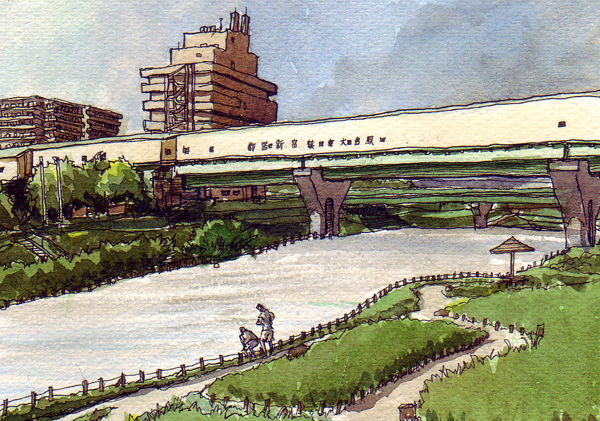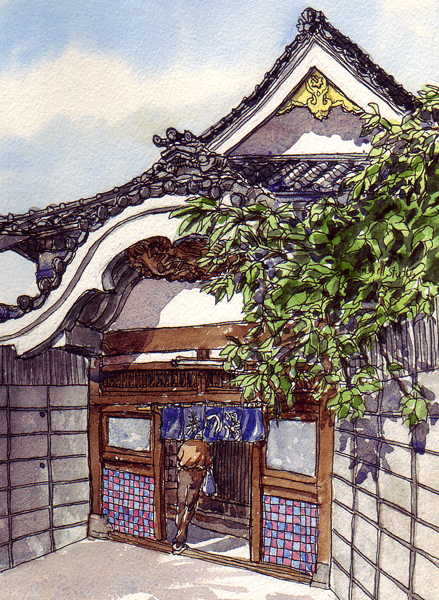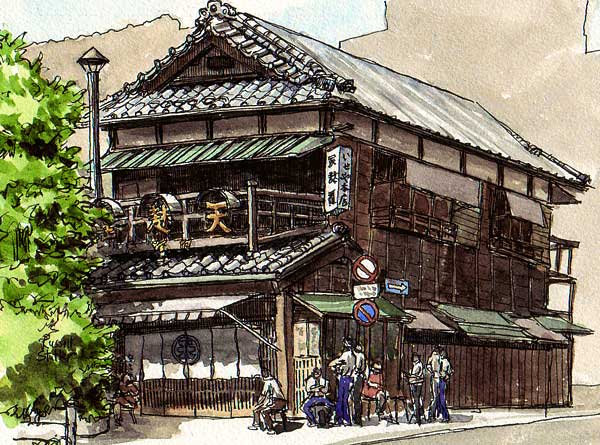 | ||
|
Another view of the Kyu Nakagawa river (Aug 2006) This is another view of the Kyu (old) Nakagawa River with the local subway station above it. The other sketch appears on page 4. This is always quiet place (for crazy Tokyo) although I hear this small river is well known not only for its historical significance, but also for its good fishing. As I have mentioned before, this used to be a major river during the Edo era, and was much wider before much of the water was diverted to the nearby Arakawa River. The people in the foreground are standing on what used to be the river bed under water, and I am looking down, sketching from the former bank.  I sketched this on a very hot summer afternoon. I never seem to be able to get out and sketch until the afternoon is half spent. The sun was in the west, there were almost no reflections on the water, and the sky was starting to become threatening. A summer rain fell soon after I finished this one. This sketch was done with fountain pen filled with carbon ink plus watercolors applied with a waterbrush on rough watercolor paper. Another neighborhood public bath This is another sketch of a "sento" or public bath. The other one appears on page 2. I'm always pleasantly surprised to come across one of these since they are rapidly disappearing. There used to be one a few blocks from my home, but it's a parking lot now. I came across this one when riding a bike around my neighborhood in search of subjects to sketch. I have been living in this neighborhood for nearly 20 years and never knew this sento was here, and it is practically within walking distance.  As I sketched it during late afternoon, the owner came out, slid open the door and hung the small curtains (called noren) on a bamboo pole above the entrance. On the noren is the name of this sento: "HARU NO YU" or Haru means spring (the season) and YU means hot water. Soon customers started gathering for their evening bath, mostly old people who have lived in their old homes with no baths for who knows how long. They would greet each other and chat, or if one was leaving as the other was entering, you would hear something like, "The water is nice and hot, take your time and enjoy!" These people have been bathing together for many years. If this sento vanishes like most have, I don't know what these people will do. Over the door, just under the arch is a solid wood relief sculpture that is packed with so much detail, it's hard to tell what it is. I could find a few cranes with wings spread, twisting in and out of each other. This sketch was done with fountain pen filled with carbon ink plus watercolors applied with a waterbrush on rough watercolor paper. An old Japanese tempura shop in shitamachi This is a sketch of an old tempura shop in the shitamachi (low city) area of Tokyo, north of Asakusa. During the Edo era, the castle compound and surrounding residences were on an elevated area in the center of the city, and this area was surrounded by the lower areas where the common folk lived. While the powerful and glamorous citizens lived in the upper parts where life was governed by many social conventions, the lower classes of people lived in shitamachi, pretty much free from the social constraints that ruled life up on the hill. Even today there is an old, romantic, distinctly Japanese atmosphere in shitamachi as contrasted with the modern even westernized atmophere of other parts of Tokyo. My neighborhood is considered shitamachi although it is on the outskirts of shitamachi. Most of my sketches are from shitamachi because that's what appeals to me most. I get an uneasy feeling if I wander to the modern, high class ritzy parts of town, and begin to crave my shitamachi.
 As I sketched this several old people came up to watch and point out to me that this was a famous old restaurant. One little girl passed behind me several times, and I figured her mother had sent her out on several errands, but as I stood up at the end of the sketch, she ran up and asked if she could photograph this sketch with her mobile phone, which I gladly let her do. As I walked back to Asakusa from this shop, I discovered I was in the Yoshiwara district, which I did not know still existed. During the Edro era it was the only area where prostitution was permitted, and was packed with businesses of this type. Back then the area was fenced off and entrance through the gates was restricted to certain classes including samurai. The street I walked on was lined with shady businesses and men dressed in tuxedos stood in every doorway beckoning me to come inside. And this was at around 3:00 in the afternoon! I asked one of these men if this area was indeed that famous Yoshiwara district. He replied yes, turned to his colleague (or rival) in the next doorway, and they both grinned with an incredulous look on their faces that I didn't know where I was. This sketch was done with fountain pen filled with carbon ink plus watercolors applied with a waterbrush on watercolor paper. Keeping the sketch box lid propped at an angle I prefer a sketch box that includes space for all my tools plus a lid to serve as an easel so I can just open the sketch box and start right in. The lid needs to be kept propped up at an angle so watercolors can flow properly, and this is usually done with the left hand (for right handers). Of course this can be a problem if you need your left hand for anything else, and it can also get tiring after a while. To address this problem, I added a three sided strip of wood near the hinge so that the lid will naturally stay open at a 45 degree angle. This turned out to be a very simple solution that worked very well. My sketchboxes are very simply made. I usually glue them together with white glue, which works very well. Then I sand them thoroughly to hide my mistakes. I love to sand wood, but I don't know why. |
Next page >> |
 |
 |